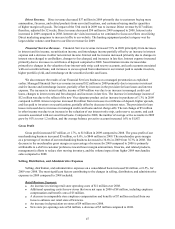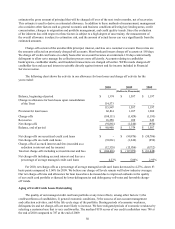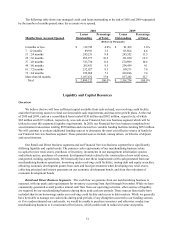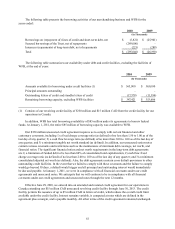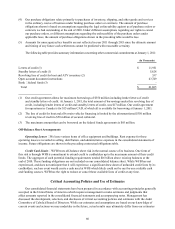Cabela's 2010 Annual Report Download - page 62
Download and view the complete annual report
Please find page 62 of the 2010 Cabela's annual report below. You can navigate through the pages in the report by either clicking on the pages listed below, or by using the keyword search tool below to find specific information within the annual report.52
Our $350 million unsecured revolving credit facility and unsecured senior notes contain certain financial
covenants, including the maintenance of minimum debt coverage, a fixed-charge coverage ratio, a cash flow
leverage ratio, and a minimum tangible net worth standard. In the event that we failed to comply with these
covenants and the failure to comply would go beyond 30 days, a default would trigger and all principal and
outstanding interest would immediately be due and payable. At January 1, 2011, we were in compliance with all
financial covenants under our credit agreements and unsecured notes. We anticipate that we will continue to be
in compliance with all financial covenants under our credit agreements and unsecured notes through the next
12 months.
Although our $350 million unsecured revolving credit facility does not expire until June 2012, volatility
and tightening in the credit markets could jeopardize the counterparty obligations of one or more of the banks
participating in our facility, which could have an adverse effect on our business if we are not able to replace such
credit facility or find other sources of liquidity on acceptable terms. We currently expect all participating banks to
provide funding as needed pursuant to the terms of our credit facility.
Effective June 29, 2010, we entered into an amended and restated credit agreement for our operations in
Canada extending our $15 million Canadian dollars (“CAD”) unsecured revolving credit facility through June 30,
2013. The credit facility permits the issuance of up to $5 million CAD in letters of credit, which reduce the overall
credit limit available under the credit facility. Interest remains variable, is computed at rates which are defined in
the agreement plus a margin, and is payable monthly. All other terms of the credit agreement remained unchanged.
Financial Services Business Segment – The primary cash requirements of WFB relate to the financing
of credit card loans. These cash requirements will increase if our credit card originations increase or if our
cardholders’ balances or spending increase. WFB sources operating funds in the ordinary course of business
through various financing activities, which include funding obtained from securitization transactions, borrowing
under its federal funds purchase agreements, obtaining brokered and non-brokered certificates of deposit, and
generating cash from operations. WFB completed term securitization transactions for $500 million in April 2009
and $300 million in February 2010 under the Term Asset-Backed Securities Loan Facilities (“TALF”) program.
The most senior class of asset-backed notes issued in the transactions qualified as “eligible collateral” under the
TALF program provided by the Federal Reserve Bank of New York (“FRBNY”). Under the TALF program,
the FRBNY provided non-recourse funding to eligible investors who purchased TALF eligible asset-backed
notes sponsored by WFB. No funding was provided directly to WFB. The TALF program ceased making new
loans secured by eligible collateral backed by credit card receivables on March 31, 2010. WFB does not have any
significant continuing obligations under the TALF program, except that under certain circumstances WFB must
notify the FRBNY and investors if the asset-backed notes cease to qualify as eligible collateral under the TALF
program and WFB agrees to provide certain information regarding the asset-backed notes to the FRBNY. During
2010, WFB renewed its $260 million and $412 million variable funding facilities that will mature in November
2011 and September 2011, respectively, and completed an additional $250 million term securitization. In 2011,
WFB intends to issue additional certificates of deposit and additional term securitizations or variable funding
facilities. We believe that these liquidity sources are sufficient to fund WFB’s foreseeable cash requirements and
near-term growth plans.
WFB is prohibited by regulations from lending money to Cabela’s or other affiliates. WFB is subject to
capital requirements imposed by Nebraska banking law and the Visa membership rules, and its ability to pay
dividends is also limited by Nebraska and Federal banking law. If there are any disruptions in the credit markets,
our Financial Services business, like many other financial institutions, may increase its funding from certificates
of deposit which may result in increased competition in the deposits market with fewer funds available or at
unattractive rates. Our ability to issue certificates of deposit is reliant on our current regulatory capital levels. WFB
is classified as a well-capitalized bank, the highest category under the regulatory framework for prompt corrective
action. If WFB were to be classified as an adequately-capitalized bank, which is the next level category down from
well-capitalized, we would be required to obtain a waiver from the FDIC in order to continue to issue certificates of
deposit. In addition to the non-brokered certificates of deposit market to fund growth and maturing securitizations,
we have access to the brokered certificates of deposit market through multiple financial institutions for liquidity
and funding purposes.







